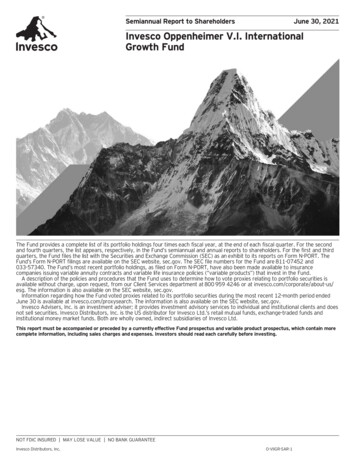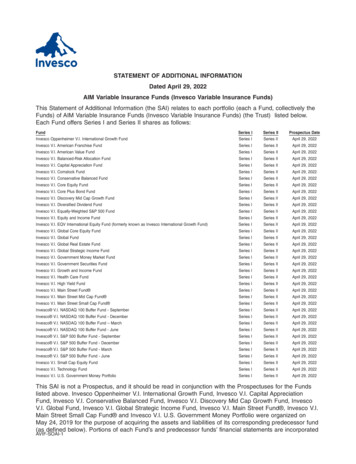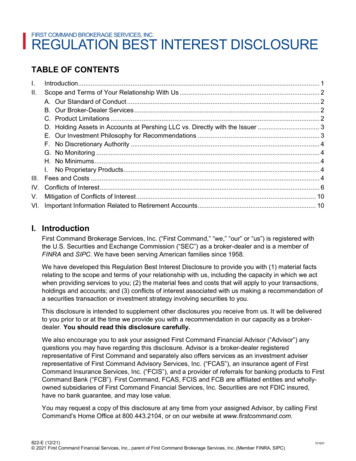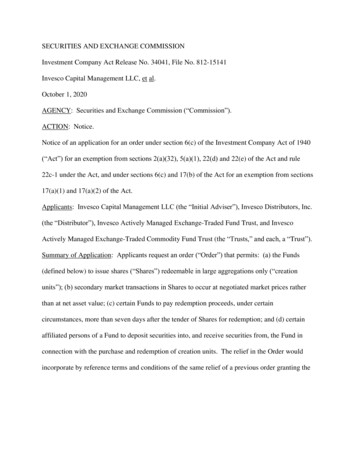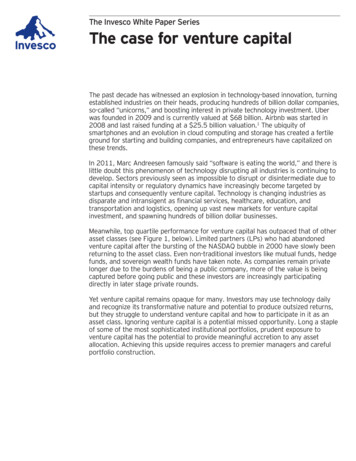
Transcription
The Invesco White Paper SeriesThe case for venture capitalThe past decade has witnessed an explosion in technology-based innovation, turningestablished industries on their heads, producing hundreds of billion dollar companies,so-called “unicorns,” and boosting interest in private technology investment. Uberwas founded in 2009 and is currently valued at 68 billion. Airbnb was started in2008 and last raised funding at a 25.5 billion valuation.1 The ubiquity ofsmartphones and an evolution in cloud computing and storage has created a fertileground for starting and building companies, and entrepreneurs have capitalized onthese trends.In 2011, Marc Andreesen famously said “software is eating the world,” and there islittle doubt this phenomenon of technology disrupting all industries is continuing todevelop. Sectors previously seen as impossible to disrupt or disintermediate due tocapital intensity or regulatory dynamics have increasingly become targeted bystartups and consequently venture capital. Technology is changing industries asdisparate and intransigent as financial services, healthcare, education, andtransportation and logistics, opening up vast new markets for venture capitalinvestment, and spawning hundreds of billion dollar businesses.Meanwhile, top quartile performance for venture capital has outpaced that of otherasset classes (see Figure 1, below). Limited partners (LPs) who had abandonedventure capital after the bursting of the NASDAQ bubble in 2000 have slowly beenreturning to the asset class. Even non-traditional investors like mutual funds, hedgefunds, and sovereign wealth funds have taken note. As companies remain privatelonger due to the burdens of being a public company, more of the value is beingcaptured before going public and these investors are increasingly participatingdirectly in later stage private rounds.Yet venture capital remains opaque for many. Investors may use technology dailyand recognize its transformative nature and potential to produce outsized returns,but they struggle to understand venture capital and how to participate in it as anasset class. Ignoring venture capital is a potential missed opportunity. Long a stapleof some of the most sophisticated institutional portfolios, prudent exposure toventure capital has the potential to provide meaningful accretion to any assetallocation. Achieving this upside requires access to premier managers and carefulportfolio construction.
Strong historical performanceVenture capital (VC) involves investment in startup companies which are traditionally high growthand often technology-centric. A venture-backed company will typically raise multiple rounds offinancing before reaching an exit, which is often either in the form of a sale to a larger incumbent orthrough an initial public offering (IPO). As an asset class, venture capital has the potential to providesignificant alpha to a portfolio and therefore has been a fixture in sophisticated institutional investorportfolios for years.Venture capital investment can be an attractive addition to most diversified portfolios. Because aventure firm’s underlying investments are in nascent companies, often with new business models oralgorithms, venture capital is inherently risky and illiquid. Investors therefore need to becompensated by higher potential returns.Top quartile absolute returns for venture capital have historically exceeded those for other assetclasses. In particular, when one compares the top quartile of managers across any time horizonshown below, venture capital has dramatically outperformed.2Figure 1: Historically outsized returns (%)Top quartile5-year10-year15-year20-yearVenture capitalAsset4838299225-year57Private equity2522273131Real estate2724262424Large-cap equity1275810High yield bonds56768Aggregate core bond45556Source: Cambridge Associates Global Venture Capital, Global Private Equity, and Global Real Estate Benchmarks Return Report.Private equity asset class excludes venture capital. 5-, 10-, 15-, 20-, and 25-year returns representative of average pooled IRRfor vintages dating back from 2014. Top quartile returns for all asset classes shown. Large-cap equity proxy is Lipper aggregatedUS large-cap equity fund performance. High yield bond proxy is Lipper aggregated high yield bond fund performance. Aggregatecore bond proxy is Lipper aggregated core bond fund performance. Returns as of Dec. 31, 2015. Sample size for each assetlisted is as follows: venture capital: 91-440; private equity: 174-630; real estate: 71-207; large-cap equity: 62-674; high yieldbonds: 30-421; and aggregate core bond: 22-385. Past performance is not a guarantee of future results.Moreover, investors are able to diversify away much of the idiosyncratic risk through investment in aportfolio of venture funds (which in turn have a portfolio of underlying company investments). Forinstance, a fund-of-funds can be a potential way to benefit from the additional alpha generated byventure capital without some of the associated volatility.Beyond generating additional alpha, venture capital can provide diversification benefits to an overallasset allocation as well. Despite being a pro-cyclical asset class, venture capital has exhibited low tomoderate correlations with other asset classes. Although some of the effect can be attributed to thelack of daily pricing for venture, these correlations likely also stem from the long-term nature of theasset class and the influence on performance of technology.Figure 2: Modest correlation with other asset classesCorrelation among asset classes' quarterly returnsVenturecapitalPrivateequityReal estateLarge-capequityHigh yieldbondsAggregatecore bondVenture capital1.000.710.69-0.06-0.13-0.13Private equity0.711.000.650.460.33-0.06Real estate0.690.651.000.130.03-0.11Large-cap equity-0.060.460.131.000.730.13High yield bonds-0.130.330.030.731.000.35Aggregate core bond-0.13-0.06-0.110.130.351.00Source: Cambridge Associates Global Venture Capital, Global Private Equity, and Global Real Estate Benchmarks ReturnReport. Venture capital, private equity and real estate data from Cambridge Associates. Private equity asset class excludesventure capital. Large-cap equity proxy is Lipper aggregated US large-cap equity fund performance. High yield bond proxy isLipper aggregated high yield bond fund performance. Aggregated core bond proxy is Lipper aggregated core bond fundperformance. Returns for period dating 1990-2014, as of Dec. 31, 2015. Sample size for each asset listed is as follows:venture capital: 771; private equity: 932; real estate: 309; large-cap equity: 674; high yield bonds: 421; and aggregate corebond: 385. Past performance is not a guarantee of future results.2
Thus, venture capital can improve both the risk and return profiles of a portfolio; however, given thelong-term nature, it is difficult to time the venture market. Some of the best vintages for venturewere 2004-2008, after many investors had abandoned the asset class due to the poor returns ofearlier vintages following the bursting of the technology bubble. In addition to making lucrativeinvestments in the newly out-of-favor internet sector, funds raised in this period tended to be moreappropriately sized and often maintained a more dedicated focus on early stage investing, bothpotential recipes for success. Maintaining consistent exposure can be crucial to a successful ventureprogram and realizing outsized returns.Endowment modelEndowments are often considered among the most sophisticated of institutional investors and havebeen among some of the more successful investors in venture capital.3 They were some of the first tounderstand the positive impact a well-crafted venture program can have on a portfolio’s return. Manyhave been consistent investors in the asset class since the 1960s and remain the most ardentsupporters today. As a result, they often have some of the best access to high-quality funds.Figure 3: Endowment asset allocationsDetailed asset allocatioins for fiscal year 2015 (%)TotalinstitutionsOver 1B 501M 1B 101 500M 51 100M 25 50MUnder rnational equities19192021201815Alternative strategies52574434251611Private equity101275320Marketable alternatives202122171387Venture capital5731100Private equity real estate6743220Energy6643211Commodities and managed futures1111111Distressed debt2211000Alternatives not broken out2123322Short-term/other44655684Domestic equitiesFixed incomeShort-term securities/cash324334Other1122123Short-term not broken out0100101Source: NACUBO-Commonfund Study of Endowments , 2015. NACUBO, www.nacubo.org.The average endowment committed 5% to venture capital in 2015, but the larger the size of theendowment, typically the greater the allocation. One of the more long-standing (and successful)endowment investors in venture capital is the Yale Endowment. Yale began its venture capitalprogram in 1976 and has achieved a 33.8% annualized IRR since inception. They have steadilyincreased their allocation to venture capital over the past few years and it now exceeds 16% of theirtotal 25.6 billion endowment in 2015, up from 10% in 2011.4Other large investors, such as state pension funds and sovereign wealth funds, have increased theirallocations to venture capital where viable, but are often constrained by their large investment checksize and an inability to access top managers.3
Size: Performance biasDespite the relatively high top quartile returns that venture capital has experienced as an asset class,performance tends to be biased towards certain pockets of the market. Unlike other alternative assetclasses like private equity and real estate, venture capital does not scale effectively. Once a venturecapital fund grows beyond 400-500 million in size, performance often begins to suffer.5 It ischallenging for firms managing large pools of capital to achieve venture-type returns when themajority of exit outcomes occur at relatively modest valuations. In 2015, the median exit valuationwas 121 million, representing a decline of almost 14% from 2014 levels.6 Large firms are eitherforced to invest in more companies or more typically invest more dollars in each company. The formerdilutes returns and reduces the amount of time a partner can dedicate to helping each company. Thelatter inevitably pushes a fund’s dollar-weighted capital into larger, later stage rounds at higherpre-money valuations. Moderately-sized funds are in a better position to participate in prudently-sizedrounds and are therefore uniquely suited to potentially generate consistent, strong returns.In addition, due to the lean startup method as well as developments in cloud computing and coworking space, the cost of getting a company off the ground has never been lower. As a result, therequisite initial investment from VCs is smaller and appropriate early stage fund sizes are smaller.Finally, similar to all alternative investment vehicles, as funds scale, managers are reaping significantsums off management fee income and are less incentivized by carried interest. This alters thealignment of interest between General partner (GP) and LP.Figure 4: Small funds have outperformed larger fundsAverage pooled IRRs - Fund size (USD)(%)20 100M 100M- 400M20.019.4 400M- 1B 1B151057.22.4Source: Preqin Global Venture Performance as of Dec. 31, 2015, inclusive of all available vintage years dating from1969-2015. Sample size for 100M is 532; 100M- 400M is 365; 400M- 1B is 111; and 1B is 20. Past performanceis not a guarantee of future results.Unfortunately, many investors are compelled to invest in larger vehicles to get allocations that aremeaningful given the size of their plans. High-quality, smaller funds often have limited capacity aswell, further forcing investors upstream.Stage: Performance biasWhile related to fund size, investment stage is an important and at times independent determinant ofventure capital strategy and performance. Venture capital funds range in strategy from “micro VCs”which focus on the seed stage, to traditional early stage firms which initially invest in Series A and Brounds through to lifecycle, and finally late stage vehicles, which invest the bulk of their capital inSeries C rounds or later. Late stage investors are particularly exposed to the potential for downrounds as they’re more reliant on less frequent, outsized realizations in order to achieve similarreturns to early stage investors. Unsurprisingly, given the risk profile of the underlying companies,early stage funds outperformed later stage funds by a fairly wide margin, roughly 800 basis pointsper year dating back to 1969.74
Figure 5: Early stage funds outperformed late stage fundsAverage pooled IRRs - Fund strategy(%)20Early stageLate stage19.71511.6105Source: Cambridge Associates Global Venture by Strategy, as of Dec. 31, 2015, inclusive of all available vintage years datingfrom 1981-2015. Early stage data represents 1,278 funds and late stage data represents 214 funds. Past performance isnot a guarantee of future resultsAlthough the standard deviation of early stage funds is higher, much of this excess risk can bemitigated through diversification. A single early stage venture capital fund will typically have 25-75portfolio companies. A portfolio of early stage funds could have as many as 500 underlying portfoliocompanies, alleviating much of the diversifiable, company-specific risk, while maintaining thepotential for outperformance.The opportunity with small and early stage managers is evident, yet many LPs continue pouringmoney into large, late stage focused vehicles, compounding the problem, or withdrawing from theasset class entirely. However, even those LPs which attempt to invest in smaller, earlier stage fundsstruggle to do so effectively. They simply cannot access the best early stage managers. As a result,we believe that many sophisticated investors which traditionally eschew fund-of-funds on the privateequity side should recognize the value of a fund-of-funds for venture capital.Access is everythingTop quartile performance in venture has been outstanding. Moreover, the disparity between the topquartile and bottom quartile is greater in venture capital than in any other asset class. The differencebetween the top quartile and median in venture is larger as well.8 In fact, “since 2000, the averageVC fund has underperformed public markets by about 5% over the life of the fund.”9 Investing withjust any venture firm contains the same risk, but may not yield the exceptional results that make theasset class attractive.To be successful in venture capital, it is imperative to access the best managers. Unlike most otherasset classes, which follow a normal return distribution, venture return distributions tend to beskewed, with a small number of managers generating a disproportionate amount of the returns.Figure 6: Returns have an asymmetric distributionRight-skewed distribution of US venture returns% of financings in companies going out of business, acquired or IPO, 2004-20130-1X% offinancings1-5X5-10X10-20X20-50X50X 1.10.4706064.8504030201025.35.92.5Source: Seth Levine, “Venture Outcomes are Even More Skewed Than You Think,” www.sethlevine.com, Aug. 12, 2014. Pastperformance is not a guarantee of future results.5
This phenomenon is driven by the outsized outcomes produced by the best venture-backed startups.For instance, Accel Partner’s 12 million investment in Facebook produced 6 billion in gains for thefund.10 This is compounded by the tendency for the top venture capital funds to gain access to adisproportionate number of the best outcomes in any given vintage. The most talented foundersoften have a choice from whom they raise capital. Many of them value the right VC partner (whetheran individual or a firm) over the terms of the round, leading to the best VCs continuing to receive thebest deal flow. This phenomenon can often lead to another unique dynamic of venture capital —persistence of performance.Most traditional asset classes, which are focused on publicly-traded, fairly efficient markets tend toexhibit mean reversion (or regression). Even top mutual funds rarely outperform the benchmark overan extended period of time. For example, the vast majority of US mutual funds underperformed overthe last decade.11 Venture capital performance, however, has tended to be persistent. In other words,if a fund has been top quartile in one vintage, there is a higher likelihood that their next fund willbeat the benchmark as well.12 Again, this is attributed to the ability of entrepreneurs to choose theirpartners. These entrepreneurs will seek out individuals and firms who have been involved with priorsuccessful, often high-profile outcomes. Accessing these top managers is challenging for investors.Perhaps less appreciated, the cohort of established venture capital firms is complemented in anygiven vintage by new, emerging funds employing innovative strategies. According to CambridgeAssociates, the 10-year period from 2004-2014 saw emerging managers capture upwards of40%-70% of the total returns for the asset class.13 Dedicated exposure is crucial in order forinvestors to capture these returns. Some of these funds will become the new top-tier venturemanagers and it is imperative to both identify and access them early. Investing merely with the oldvanguard of venture firms will cause LPs to miss out on the full spectrum of outsized returns, as wellas the potential ability to invest with emerging top performers later on.Current environmentVenture capital has enjoyed strong performance over the past 5-10 years, leading to increasedfundraising and investment activity.14Figure 7: Activity remains elevatedUS venture capital activity Deal value ( B)( B)2006 Number of deals ,425 441446879404,0002,000Source: Q2 2016 PitchBook US Venture Industry Report, PitchBook Data, Inc.Although investment activity has slowed over the past year, it remains elevated compared to levelsthroughout most of the past decade, leading many industry observers to strike a cautionary tone.Much of this capital in recent years has flowed into larger, later stage-focused investment vehicles.This has been compounded by many new, non-traditional entrants (such as asset managers likeFidelity and T Rowe Price) into the market, thereby causing most of the froth in the system to beconfined to later stage and pre-IPO rounds. As a result, while early stage pre-money valuations haveremained relatively stable over the past decade (through 2014), increasing a total of 230% (fora CAGR of 8% per year), late stage pre-money valuations have inflated 640% over the sametime period.156
A significant correction in public markets and private valuations or a dramatic rise in interest rateswill lead to a temporary pullback in private investment, particularly among new entrants. Indeed,the past 9-12 months has witnessed a correction in all private rounds, but especially so in Series Drounds or later, which on average have fallen 50% from 2015 highs.16 At the same time, the trendtoward companies staying private longer is not going away, and the inability of larger institutions toscale their investments in early stage venture capital will likely continue propping up late stagerounds. Therefore, while a prudent allocation to early stage venture should outperform late stageover the long-term (see Figure 5, above), going forward the disparity in performance could widen.ConclusionVenture capital is a dynamic asset class, spawning new industries while fueling innovation anddisruption across existing ones. Four of the five largest companies by market cap — Apple, Google,Amazon and Microsoft (with Facebook poised to replace Exxon for the fifth spot) — were venturebacked technology companies. Venture has the potential to generate exceptional returns (as well asconsiderable losses) while providing some diversification benefit to portfolios. However, in our view,investors should not merely attempt to achieve venture capital ‘beta.’ Despite the outsizedperformance of top managers, the mean and median return for the asset class is uninspiring anddoes not compensate an investor for the risk taken. In the venture capital space, access to the bestmanagers is crucial to constructing a successful portfolio, yet these premier funds are often smallerand oversubscribed, making entry that much more difficult for LPs.A thoughtfully constructed portfolio can provide access to premier venture capital funds focused onthe attractive earlier stages of funding while diversifying away much of the unsystematic risk. In thecurrent environment where there is so much opportunity in venture — and concurrently so much risk— a professional, dedicated approach to investing in the asset class is essential.Notes1 PitchBook, as of June 30, 2016.2 Cambridge Associates Global Venture Capital, Global Private Equity, and Global Real Estate Benchmarks Return Report.Returns as of Dec. 31, 2015.3 Venture Capital Investments earned an annual average of 93% from 1995-2015, The Yale Endowment 2015, YaleInvestments Office, Endowment Reports.4 The Yale Endowment 2015, Yale Investments Office, Endowment Reports.5 Preqin Global Venture Performance as of Dec. 31, 2015, inclusive of all available vintage years dating from 1969.6 PitchBook Venture Deal data, VC-backed exits Jan. 1, 2015 through Dec. 31, 2015.7 Cambridge Associates Global Venture by Strategy, as of Dec. 31, 2015, inclusive of all available vintage years datingfrom 1981.8 Cambridge Associates Global Venture Capital, Global Private Equity, and Global Real Estate Benchmarks Return Report.HFRI, Hedge Fund Research Inc. Returns as of Dec. 31, 2015.9 Robert Harris, Tim Jenkinson, Steven Kaplan, “Private Equity Performance: What do we know?” The Journal of Finance,Sept. 12, 2014.10 Ryan Mac, Accel Partners Raises New Funds Totaling Over 1 Billion As Facebook Investor Jim Breyer Reduces Role,Forbes, 3/19/2014, www.forbes.com11 Madison Marriage, “86% of active equity funds underperform”, US Mutual Funds, www.ft.com, March 20, 2016.12 “Has Persistence Persisted in Private Equity? Evidence from Buyout and Venture Capital Funds.”13 Cambridge Associates, “Venture Capital Disrupts Itself: Breaking the Concentration Curse,” November 2015.14 Cambridge Associates benchmark data.15 PitchBook, Deal Analytics Data; Average Pre-Money Valuation Mean by Strategy, Global Venture Capital.16 Cooley, Venture Financing Report: “Q2 2016 – Investment Climate Cools,” www.cooleygo.com, August 2016.7
Appendix ALifecycle of a venture-backed companyVenture capital refers broadly to the funding of startup companies across their respective life cyclesthrough to an exit in the form of a sale of the company (M&A) or taking the company public (IPO).The funding of a successful venture-backed company typically progresses across the following stages: Seed: Usually referring to the initial funding of a startup, “seed” funding has historically been thedomain of friends and family, but is now commonly regarded as the first institutional funding roundin a startup. The majority of seed funding is invested in development resources, continuing to buildout the company's initial product through the beta version. Series A: Once startups have achieved traction (usually in the form of user growth or revenue)they are primed to raise an institutional round from a traditional early stage or lifecycle investor.The product continues to be iterated on and improved as the company incorporates user feedback. Series B: The final “early stage” round, Series B companies typically have achieved product marketfit by this stage and have strong user growth, if not revenue. Companies raise capital primarily forthe purpose of investing in sales and marketing. Series C: Once a startup has reached a Series C funding, it is generally no longer considered anearly stage company. Such companies continue to fund expansion through investment in sales andmarketing. Series D: Late stage companies at this point typically remain unprofitable and continue to raisecapital to fund growth and ultimately achieve an exit, although some companies may exit beforethis stage. Series E : The last round of funding before an exit is often referred to as a “Pre-IPO round.”In recent years, such rounds have become dominated by non-traditional startup investors, likesovereign wealth funds, mutual funds and hedge funds. IPO or M&A: Successful venture-backed portfolio companies traditionally exit one of two ways:either through a sale to a larger company or through an IPO. While IPOs tend to get moreattention from the media, M&A transactions have been the more consistent form of exit forstartups of all stages.Recent years have seen venture-backed companies remain private for longer, due to the burdensassociated with being a public company and an abundance of capital willing to invest in late-stageprivate financings. This has furthered the presence of non-traditional investors in later stagerounds, as more of the value can be increasingly captured pre-IPO.8
Appendix BA brief history of venture capitalThe history of venture capital dates back to the late 1940s when George Doriot, then professor atHarvard Business School, founded American Research and Development (ARD), likely the world’s firstinstitutional grade venture capital firm. Until that point, investments in private companies had beenthe province of wealthy individuals and families like the Rockefellers and Whitneys. Boston-based andpublicly-traded ARD was one of the first independent firms providing sustained risk capital to privatecompanies. Its most notable investment was a 170,000 investment in 1957 in Digital Equipment(DEC), a mini-computer company that earned the firm 500 times its investment cost upon goingpublic in 1966.The 1960s and 1970s saw the rise of venture capital firms on the West Coast paralleling thedevelopment of the semiconductor industry in Silicon Valley. Perhaps the most highly-regarded andtransformational venture-backed company of this period was Fairchild Semiconductor. Backed byArthur Rock, an eight member team of Fairchild alumni headed by Gordon Moore and Robert Noycespun out to start Intel Corporation. Several Intel and Fairchild employees later became key membersof illustrious venture capital groups like Kleiner Perkins Caufield & Byers and Sequoia Capital.A significant development in the evolution of the venture industry was the clarification of the“prudent man rule” in the 1974 Employees Retirement Income Security Act (ERISA). In 1979, theUS Labor Department specified that ERISA diversification allowed pension funds to includealternative assets in their portfolio mix. As a result, a flood of money began entering the industry.In 1978, 23 venture funds managed about 500 million of capital. By 1983, there were 230 firmsoverseeing 11 billion.17In the late 1970s and early 1980s venture funding evolved from a focus on semiconductors anddata processors to include sectors like personal computers and medical technology. The successfulpublic offerings of venture-backed companies like Apple, Fedex, Home Depot and Genentech broughtsignificant attention and increased funding to the still-nascent asset class.The 1990s saw the exponential growth of the industry around a revolution in software and thedevelopment of the internet. This culminated in the ‘irrational exuberance’ of the late 1990s and thebursting of the internet bubble in 2000. Although the decade did produce a number of lastingtechnology conglomerates like Google, Amazon and Paypal, most of the startups which emerged inthe late 1990s were ahead of their time and absent any tangible traction. Venture capital fell out offavor in the years following the tech bubble collapse. Even as recently as 2009 and 2010, it was stilldifficult for high-quality VC firms to raise capital with 10-year performance numbers still negative.This disinterest in the asset class masked significant innovation taking place. The internet was finallydelivering on the hype of the late 1990s and producing companies with sustainable business models.Social media was taking off, epitomized by exponential growth at startups like Facebook, Twitter andLinkedIn. On the back of mega trends like “social,” followed by “mobile” and “cloud,” software beganeating the world, disrupting any and all industries in its path, irrespective of capital intensityor regulation.Which brings us to today. After the high profile successes over the last decade, startups have neverbeen more in vogue, with engineers and MBAs choosing the suddenly glamorous life of an founderover positions in finance and consulting firms. Disruption continues apace, and venture capital hasrebounded to capitalize on the opportunities.17 Spencer E. Ante, Creative Capital: Georges Doriot and the Birth of Venture Capital, Harvard Business Press,as of Dec. 30, 2013.9
Important InformationThis document has been prepared only for those persons to whom Invesco has provided it for informational purposes only. This document is not an offering ofa financial product and is not intended for and should not be distributed to retail clients who are resident in jurisdiction where its distribution is not authorizedor is unlawful. Circulation, disclosure, or dissemination of all or any part of this document to any person without the consent of Invesco is prohibited.This document may contain statements that are not purely historical in nature but are "forward-looking statements," which are based on certain assumptions offuture events. Forward-looking statements are based on information available on the date hereof, and Invesco does not assume any duty to update anyforward-looking statement. Actual events may differ from those assumed. Th
High yield bond proxy is Lipper aggregated high yield bond fund performance. Aggregate core bond proxy is Lipper aggregated core bond fund performance. Returns as of Dec. 31, 2015. Sample size for each asset listed is as follows: venture capital: 91-440; private equity: 174-630; real estate: 71-207; large-cap equity: 62-674; high yield




